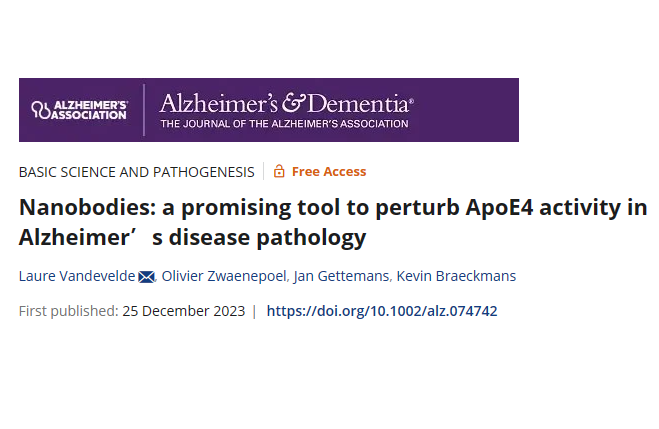Nanobodies: a promising tool to perturb ApoE4 activity in Alzheimer's disease pathology

Alzheimer's & DementiaVolume 19, Issue S13 e074742
BASIC SCIENCE AND PATHOGENESIS
https://doi.org/10.1002/alz.074742
Abstract
Background
The APOE-ε4 allele encoding for apolipoprotein (apo) E4, an isoform of the APOE gene, is the strongest genetic risk factor for Alzheimer’s disease (AD). The exact mechanism by which apoE4 increases this risk is not fully understood. However, apoE4 has a very different structure than the other isoforms, apoE2 and apoE3, and it is suggested that this different structure contributes to the development of AD1. More efforts are still needed to further understand how apoE4 contributes to AD pathogenesis. Single domain antibodies or nanobodies are versatile tools to reveal new information on apoE4 and its pathological effects in AD.
Methods
Nanobodies are routinely obtained from immunized camelids, or from naïve libraries. Nanobodies need to be characterized by i.e. immunoprecipitation with apoE2, apoE3 and apoE4 and their affinity can be determined via an Octet device. Via laser-induced photoporation, nanobodies can be delivered into living induced pluripotent stem cell derived APOE-ε4 homozygous neurons. Nanobodies can be tagged with a fluorophore via click chemistry and derivates can be made by equipping them with a degradation or delocalization tag (cloning).
Results
Llama immunization will lead to a set of ApoE-targeting nanobodies which will be further reduced to a couple of nanobodies after their further characterization (specificity and affinity). Given the high similarity between apoE isoforms, it is to be expected that some nanobodies will cross-react with different isoforms. Because nanobodies recognize conformational epitopes it is likely that ApoE4 nanobodies can be generated.
Delivery of the nanobodies into apoE4 expressing neurons allows to manipulate endogenous apoE4 and as such our approach does not require expression modulation of the target: the protein can be degraded or it can be trapped/relocated to different regions or organelles in cells. We aim to perturb apoE4 in a way that typical AD pathologies seen in AD neurons are ameliorated and as such gain more insight about the pathophysiology of apoE4 effects in AD.
Conclusion
Nanobodies are excellent tools to uncover new biological information concerning apoE4.
References:
1 Najm, R., Jones, E. A., & Huang, Y. (2019). Apolipoprotein E4, inhibitory network dysfunction, and Alzheimer’s disease. Molecular neurodegeneration, 14(1), 1-13.